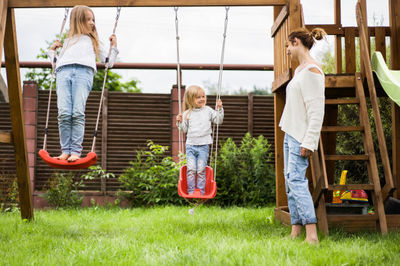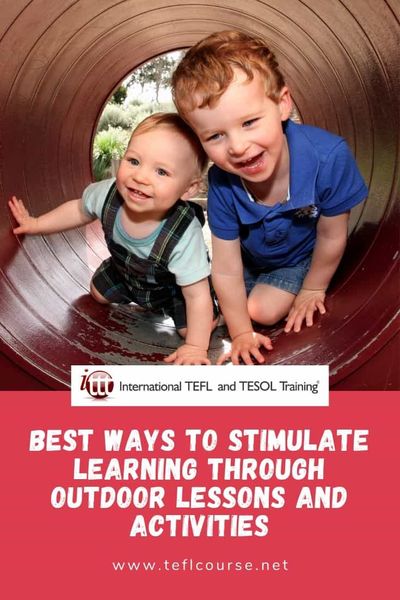Going Outside: Stimulating Learning Through Outdoor Lessons and Activities

One of the key elements to being an effective teacher is variety. One cannot teach by using the same lesson structure, the same activities, the same worksheets, the same plan every single time. No matter how effective it may be, students will still tire from the repetition, and their engagement will wane. And that is exactly why teachers have a toolbox from which to draw a wide variety of skills, activities, plans, and ideas to keep the classroom fresh and engaging. Changing scenery, environments, and going outside is all part of this toolbox, and can be used to an effective extent to keep lessons feeling stimulating and varied. And by doing so, the teacher is opening up lessons to a fun and exciting range of possibilities for activities that would not be possible by always staying indoors.
Table of Contents
Outside Activities for Younger Children
Outside Activities for Older Students
Are you ready to teach English to different groups of students?
This post was written by our TEFL certification graduate Nicholas N. Please note that this blog post might not necessarily represent the beliefs or opinions of ITTT.
Classroom Environment
One of the keys to language learning is that students feel comfortable and open. And for many, leaving the traditional classroom environment can be exactly what helps them open up to trying new things and experimenting because they are not restricted by walls and stuck to desks. In addition, by being outside, the whole world has now become the classroom. Language learning does not have to begin from textbooks or a curriculum, but it can begin with even something as seemingly insignificant as a stick. With merely a stick, the teacher can teach about size and length; color and texture; verbs like 'to throw,' 'to snap,' 'to poke'; the modal verb 'can'; one can tangentially discuss trees, the earth, or any other range of topics. In this way, the Engage phase of a lesson can begin with tactile objects and things experienced with the senses. Something as simple as a stick can quite literally become a branching off point for discovering and teaching language, but that is not apparent when learning is restrained to remaining indoors.

Also Read: How much can I earn teaching English abroad?
Outside Activities for Younger Children
Once outside, possible ideas for activities are endless. First, maybe with younger children, the teacher wants to stay on school grounds. Outside, desks, chairs, and walls are not a problem, so role-playing, charades, or other body movement activities become very possible. With props even, students could act out their perfect day in a game of charades, or role-play going to the beach and not feel like they are limited in their actions or movements. Playing sports in the target language also becomes possible, and students get that variation in thinking through using both their bodies and their minds. In addition, friendly competition can always drive learning, even with concepts like numbers. The class could be split into individuals, pairs, or teams, and each is given a jump rope. Teams or individuals have to count off in the target language when they successfully complete a jump, and whoever goes the longest with successful jumps and accurate counting is the winner. This provides an application of students' knowledge of numbers, provides friendly competition, and only requires a rope. And yet, it would not be possible inside the classroom, because there just is not enough space. Finally, another simple activity is combining "I spy" and sentence memorization. A student begins by looking around and could say, "I spy a red car." And another student could add on and say "I spy a red a car and a brown dog." And so forth. This could be adapted for colors, or Present Continuous verbs, or another grammar point. And unlike the classroom, the outside environment is constantly changing so this game would constantly have new material to use.

Also Read: My Experience Taking a TEFL Course with ITTT
Outside Activities for Older Students
Perhaps for an older group of students, exploring off of school grounds can also be fun and effective. Using activities where students might have to converse with real people could help with students' preparation in applying both productive and receptive "real-life" language skills, and could be incorporated as the Activate phase of a lesson. If in an area where there are many English speaking tourists or people with a decent knowledge of English, a class could use surveys, in which students go out to the street and ask questions like "What is your favorite restaurant like?" and record the answers. These surveys can then be brought back to the classroom and discussed with the class. Students could also be sent on a scavenger hunt with English instructions like "Take a picture of an animal that cannot fly" or "Take a picture of an animal that can breathe underwater." In this way, students use their skills to accomplish a goal and also get to engage with the environment around them. Or, for a lesson on Past Tense verbs, during the Activate phase, students could go out and draw or observe a street, shop, or park, and then write a story in the past tense about what happened there, before presenting their location and story to the class.

Also Read: The 3 Most Popular ESL Games That Work in Every Classroom
More Choices
Finally, taking a video recorder outside is a fun and effective way to get students using the target language, build rapport if working in groups, and explore the world around them. Whether doing a news report, filming a role-play or skit, or giving a tour of a location, the camera can be instrumental in stimulating and effective activities. When talking about the parts in a teacher's toolbox, a video recorder is sure to come up alongside the whiteboard, coursebooks, dictionaries, audio players, and computers. But it cannot be forgotten that the outside is also part of the teacher's toolbox, and combining the outside with other toolbox items can produce fun, effective, varied, and engaging ways to boost student learning. Ultimately, there are many activities that can be done within a classroom, but by bringing the class outside, the possibilities truly become endless. From simple games like "I spy" or charades to real sports like soccer or jump rope to more complex activities like scavenger hunts or surveying real people, going outside opens the doors to a whole wealth of activities. Learning is not limited to the classroom, and bringing language learning outside can truly help it prosper.
Listen to this blog post
Are you ready to teach English to different groups of students?
Apply now & get certified to teach english abroad!
Speak with an ITTT advisor today to put together your personal plan for teaching English abroad.
Send us an email or call us toll-free at 1-800-490-0531 to speak with an ITTT advisor today.
Related Articles:
- 10 Questions You Need to Ask Before Enrolling In a TEFL Course
- 6 Tips You Need to Know About Jobs Teaching English Abroad
- The 10 Best Destinations for Teaching English Abroad in 2018
- The Best Government Programs For Teaching English Abroad
- The Best Countries for Single Women to Teach English Abroad
- What Scams to Look Out for When Looking for TEFL Jobs




